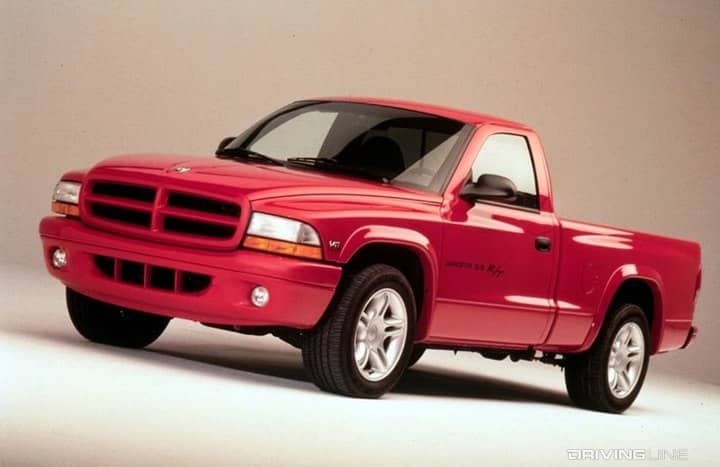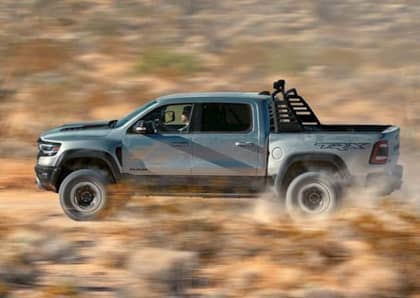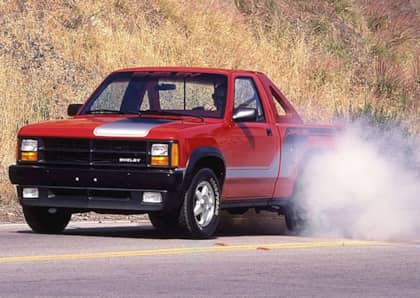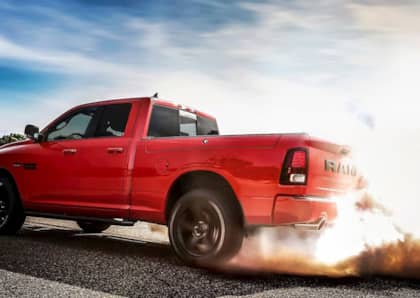1998-2003 Dodge Dakota R/T: The Last "Compact" Muscle Truck
In the annals of high performance pickups, there's a modern muscle truck that often gets overlooked. The 1998-2003 Dodge Dakota R/T—lovingly known among enthusiasts as the "Mighty Dak"—was a short-lived effort from Chrysler to transpose the tried, tested and true formula of big engine/small car onto a mid-size pickup template. That in itself isn't surprising. After all, this is the same Chrysler that would shortly thereafter stuff a Viper engine under the hood of a short-box Ram 1500, essentially embiggening the Dakota R/T concept.
No, what's puzzling is that no other mid-size truck brand would follow Dodge's lead and come out with a hi-po street model of their own. Sure, Toyota's Tacoma S-Runner/X-Runner and the Chevrolet Colorado Xtreme looked the part, but neither had anything special going on under the hood compared to their standard showroom siblings, making the Mighty Dak not just unique for its time, but the last of a dying breed.
Make It Turn
The impetus behind the R/T was the realization in 1997 among Dodge's product planners that the Dakota could already hold its own on a handling course as compared to other mid-size and compact options of its era. It wouldn't take much effort, mused the engineering team, to double-down on the pickup's nimble character and at least give it a shot at taking out a Camaro or Mustang on a twisty road.
A plan was hatched: up-size the Dakota's tires to 255/55 17 inches, drop the suspension 19 mm to bring its center of gravity that much closer to the asphalt and beef up its stabilizer bar at the back by an additional 9 mm. The brakes were also given more authority over the R/T's velocity (with discs measuring 11.3 inches in the front, but still saddled with rear drums). Instantly, the personality of the truck was transformed from affordable hauler to slalom-friendly menace.
Then there was the question of motivation. Dodge had already been ahead of the less-than-full-size pickup pack in terms of power thanks to the Dakota's available 5.2L V8, which boasted two additional cylinders over anything else available at its price point. The R/T model took things even further with the inclusion of an exclusive 5.9L V8 that was good for 250hp and 345 lb-ft of torque thanks in part to a higher-flowing dual exhaust system. A limited-slip rear differential did its best to fight for traction under full throttle, and a strengthened four-speed automatic transmission fed the V8's output to a single solid axle (without the option of four-wheel drive).

Never one to be subtle with its trucks, Dodge also gave the Dakota R/T (available in both single and extended cab body styles) a dollop of visual flair that included four unique colors: flame red, black, intense blue and deep amethyst, as well as body-colored trim all around and, of course, an enormous R/T call-out on the trucks' flank.
Fun And (Mostly) Fast
It's fair to say that the Dodge Dakota R/T is more oriented towards fun than all-out performance. As with most muscle trucks, the lack of weight over the rear wheels makes it a burn-out machine par excellence, which isn't exactly the quality a drag racer is looking for when trying to hook up for a quarter mile pass.
On the street, under ideal temperatures and conditions, it was possible to scoot the R/T to 60 mph from a standing start in around seven seconds, which was respectable for the time, and about one second slower than a Mustang GT. With a prepared track, the quarter mile vanished in just over 15 seconds at a terminal trap speed of 90 mph.
More intriguing, however, were the Dakota R/T's handling chops, which regularly caught automotive journalists of the day by surprise. In the early 2000s compact trucks were typically viewed as the consolation prize of the pickup segment, and as such were afforded little attention to their suspension setups outside of what was required for towing or heading off-road. That Dodge had delivered a competent and fun-to-drive option was a shock to the system.

Of course, there was somewhat of a price to pay for the Dakota R/T's turn away from utilitarianism towards the whimsy of speed. Due to the rear suspension configuration being so much lower, the bumper tow rating for the R/T was dropped to 2,000 lbs, a far cry from what the standard version of the Dakota was capable of. Dodge had to settle scores of complaints—and in some cases, buy trucks back—after initial advertising for the R/T failed to indicate that towing would be impacted. It's worth noting, however, that installing a Class IV hitch and air bags largely closes the gap between the sport truck and its more sedate sibling.
No Ripple Effect
Despite its fun factor, the Dodge Dakota R/T never really caught on as anything more than a novelty during its brief six-year run. Sales numbers peaked around 4,000 for the 2000 model year, which was a drop in the bucket considering that at that time the Dakota was churning over 100k units a year. In totality, just 16,496 R/T trucks were ever built, with the final year's 802 examples sold representing its nadir.
It's perhaps this under-appreciation that kept the Dakota R/T from having any meaningful impact on the future of mid-size and compact truck performance. Although Dodge would resurrect the R/T badge for the third-generation Dakota that followed, it was largely a sticker package with no meaningful performance upgrades over the base truck. GM and Ford slept on the street truck vibe completely, with only Toyota's TRD taking a break from dune-bashing to develop a supercharger kit that could be outfitted to the Tacoma—though it was not part of any specific factory model.
This trend continues to today. Although power is up across the board, there's not one performance-oriented offering outside the full-size market that could legitimately be considered the successor to the Dakota R/T. For all of the turbocharged, eight-cylinder oomph modern bucks can buy, suspension design and styling have migrated, perhaps permanently, into the off-road world where rugged trucks currently command big bucks. Dodge's 15 year-old cargo-hauling cruise missile reminds us all of a time when a factory-backed speedster didn't require a rocky trail or Baja desert to enjoy.











